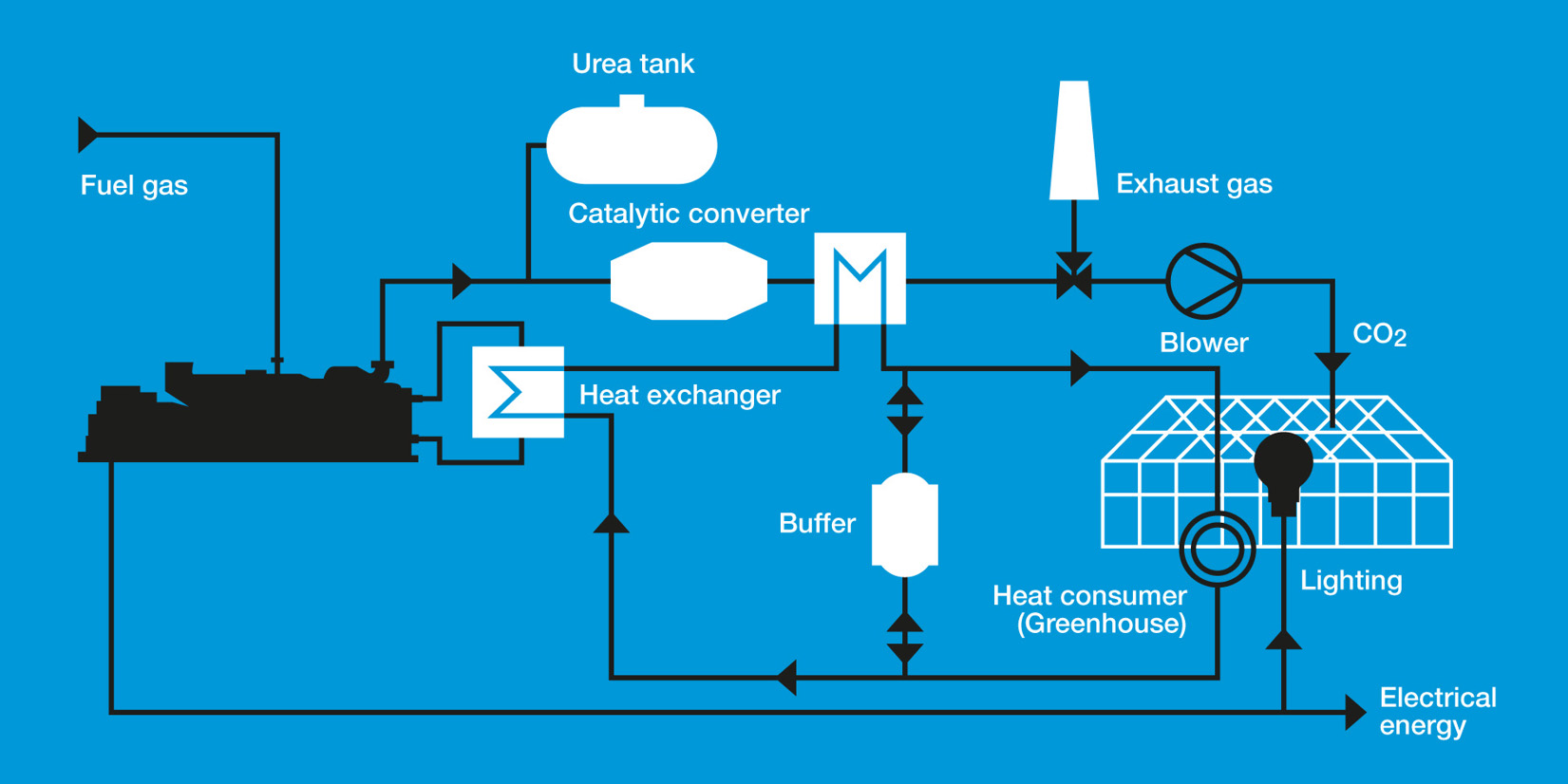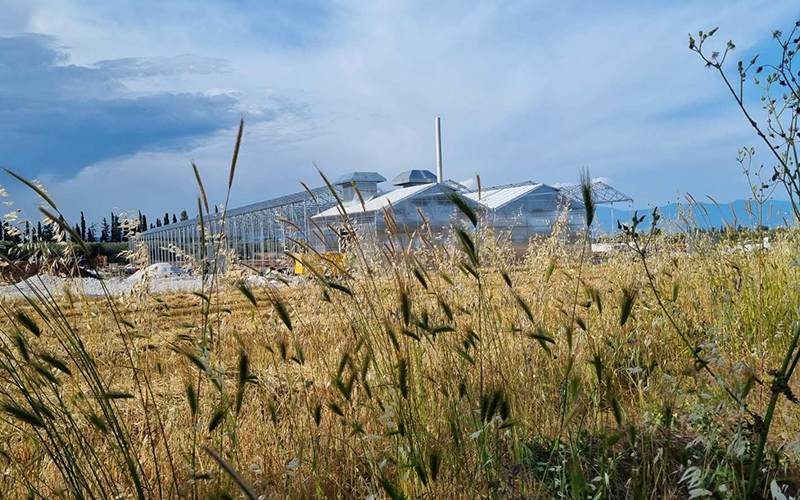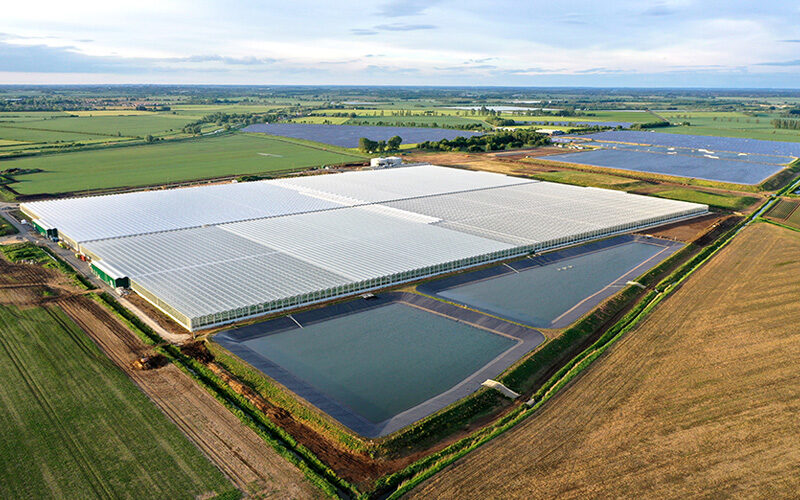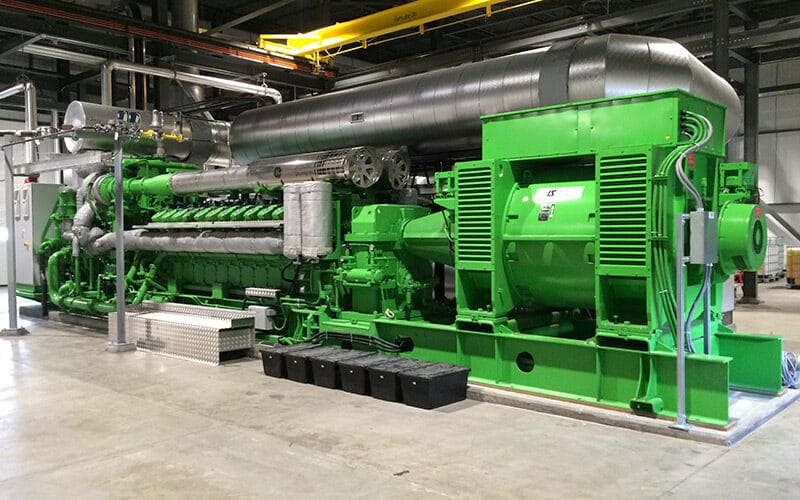
Glasshouse CHP / Cogeneration
Glasshouses or greenhouses can use combined heat and power (CHP) or cogeneration in order to provide heat, carbon dioxide and electricity. Surplus electricity can often be sold into the local electricity grid. Gas engines are highly efficient at providing the stimulus for the growth of plants, whilst in parallel providing a flexible supply of electrical power. Heat, light and carbon dioxide (CO2) all promote plant growth. Gas engines provide electrical power at the alternator and when in a cogeneration configuration can also recover useful heat. Carbon dioxide is released in the exhaust gases of the engine as a by-product of the combustion of the fuel gas. Electrical power can be used to provide energy for lighting or can be exported to the grid, heat can be stored as hot water for use when needed and finally the CO2 can be scrubbed and used to promote plant growth.



Benefits of CHP for Glasshouse Applications
- Efficiency levels up to 95%, therefore high contribution to resource conservation and maximisation of profits
- Provides power to grid at times of maximum demand hence receiving highest power sale prices
- Time-independent supply of CO2 and heat through heat storage
- High quality CO2
Carbon Dioxide from CHP Engines and Plant Growth
Plants grow by converting CO2 to carbon through photosynthesis. Air generally contains approximately 350 ppm CO2. Optimal CO2 levels depend on the type of plant and generally lie above 700 ppm. With increased artificial lighting, as present in glasshouses, plants absorb even more CO2. If the greenhouse atmosphere is enriched with CO2, the temperature kept on a constant level and enough lighting, provided plant growth and consequently the harvest yield can be increased significantly. When burning natural gas in gas engines, approximately 0.2kg CO2 is produced per kWh of energy input. This CO2 is present in the exhaust of gas engines in a concentration approximately 5-6% by volume.

Energy Usage in Glasshouses
The energy created by gas engine combined heat and power systems in glasshouses can be used in various ways. The electricity can provide the power for the artificial lighting and/or be fed into the electricity grid. The heat efficiently meets the glasshouse’s requirements. In addition, the climate relevant CO2 of the engine exhaust gas serves as a fertiliser for the plants.
Exhaust Purification
After the purification of the exhaust gas with special catalytic converters (SCR and oxidation catalytic converters), the exhaust gas is cooled down by a heat exchanger to approximately 55°C and supplied to the glasshouse for CO2 enrichment. A measurement device that constantly measures the exhaust gas levels ensures maximum safety for vegetation.
Key Figures for Glasshouse CHP
Efficient operation is possible with approximately 1 hectare (ha = 2.47 acres) or larger glasshouse areas
- CO2 fertilisation is suitable for nearly all plant types
- CO2 fertilisation with simultaneously heat supply: dimensioning for 0.5MWe/ha
- CO2 fertilisation with simultaneous heat supply and illumination dimensioning for 0.35 MWe/ha
- Illumination suitable for vegetables (e.g. tomatoes or peppers) and for flowers (e.g. chrysanthemums or roses)
- The decisive factors for economical plant operation are the high electrical efficiency, combined with the usage of heat and CO2
Clarke Energy Global Glasshouse Experience
Clarke Energy has extensive experience in greenhouse CHP scheme innovation.
Our first project was in 1999 with Independent Power on the Isle of Wight in the UK
Clarke Energy has now installed
>0.5GW Globally
Glasshouse Case Studies
Propane Powered CHP Improving Energy Efficiency of Greenhouse Operations in Greece
Agrotikes Ekmetalleyseis IKE is a greenhouse operator specialising in the cultivation of vegetables distributed throughout Greece.
AGR 217,000m² Glasshouse and Energy Centre with 33MWth Heat Pump System and 9MW Combined Heat and Power Plant
AGR has selected Clarke Energy to supply and install an innovative power generation project at a renewable heat glasshouse, one of the largest in the UK.
Coldwater Board of Public Utilities Cogeneration Plant for Greenhouse Facility, Michigan USA
The project is co-located with a 100-acre greenhouse facility that has the capability to use the engine heat and CO2 for greenhouse fertilisation.




